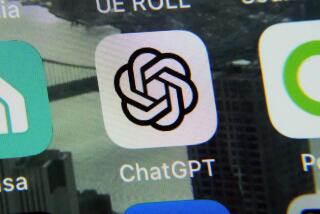Comupter Automation No Longer Wall St. Darling : Fevered Visions of Patent-License Millions Haven’t Been Fulfilled
- Share via
In April, 1987, the editor of a San Francisco high-technology investment newsletter wrote about a small Irvine company and an intriguing patent-licensing agreement it had signed with giant International Business Machines Corp.
Michael Murphy told readers of his California Technology Stock Letter that the patent, which covered a memory process inside IBM’s new Personal System/2 computer line, could produce a multimillion-dollar windfall for Computer Automation.
Almost overnight, the company was transformed from a dullard into a darling in the eyes of Wall Street. Its stock price nearly tripled, and investors expected even bigger gains to come.
But the expected rush of patent licensees and royalty payments has not materialized. Meanwhile, the firm has said it expects to report a loss for the fiscal year ended June 30. Computer Automation’s once-soaring stock has fallen back to earth.
Coal Instead of Jewel?
Some industry observers are speculating that Computer Automation’s once-promising patent may be more bust than bonanza.
“Computer Automation thought it had a crown jewel and, as it turned out, they had a lump of coal,” said an attorney who represents several computer companies that have studied the Computer Automation patent.
“The stock is in total chaos right now,” said Brian G. Swift, a San Francisco investment analyst who last spring estimated that Computer Automation would receive $3 million in royalties a year from the patent. Swift has since changed his mind.
Computer Automation Chairman George Pratt said misperceptions about the potential value of the patent helped push the stock to unrealistic prices. Nevertheless, Pratt said he still believes that the patent will be important to the company in the future.
The patent controversy has its origins in a Computer Automation laboratory in 1972 and 1973. Four company engineers were trying to build a new business computer with a design that would be all but impossible for competitors to legally duplicate.
Engineers’ Solution
The engineers finally found a solution involving the computer’s electronic bus, or main data communications pathway. Their patented design relied on an improved method for allowing the computer to determine the amount of memory storage space at its disposal and to assign each individual memory cell its own parking spot.
They called their design the Automatic Modular Memory Address System and began incorporating it in Computer Automation’s “Naked Mini” computer in 1973, years before IBM introduced its first personal computer in 1976.
When IBM was preparing to unveil its new PS/2 line in early 1987, the company discovered Computer Automation’s patent. IBM was concerned that it might have infringed the patent in designing a communications pathway called Micro Channel in certain PS/2 models. IBM signed a non-exclusive licensing agreement with Computer Automation in March.
Computer Automation’s biggest cheerleader has been Murphy, who has been editing the California Technology Stock Letter since 1982. Murphy, 46, is a Harvard graduate who worked as a computer programmer and systems analyst before turning his attention to the stock market in 1970. He worked as an investment analyst for several firms before founding his newsletter.
Murphy, who also edits a newsletter called the Overpriced Stock Service, achieved some notoriety last year when he stated three months before the Oct. 19 stock market crash that the “fair value” of the Dow Jones Industrial Average was 1,759. On Black Monday, the market plummeted 508 points to close at 1,738.
Licensing Deal Disclosed
In April, 1987, Murphy disclosed the existence of the IBM licensing deal in his newsletter.
IBM already had paid a $100,000 royalty to Computer Automation because of the patent, Murphy wrote. IBM also would have to pay Computer Automation continuing royalties for each PS/2 machine equipped with the Micro Channel, he said, and those payments could reach $1.3 million by the end of 1988.
And, Murphy said, Computer Automation’s patent was broad enough that dozens of other computer makers who wanted to produce “clones” or add-on circuit boards for the PS/2 market would need to license the patent and pay royalties to the Irvine firm.
“If mighty IBM thinks a license was needed,” Murphy wrote, “ . . . wow!” He estimated that royalties from those companies could bring another $5 million in 1989.
Those royalties could give a big boost to a company as small as Computer Automation, which reported $21 million in sales and $1.4 million in earnings for its 1987 fiscal year.
Murphy told his newsletter subscribers that Computer Automation stock, which was trading in April of ’87 for about $6 a share, could soar to $20 on the strength of the patent. He predicted that the stock would take off as soon as the company announced its first licensing agreements.
In a recent interview, Murphy said his information about Computer Automation and the IBM licensing agreement came from his own research and not from anyone at Computer Automation. “They have never leaked anything to me,” he said.
Obscure and Dull
Computer Automation is a relatively obscure company involved in two rather dull segments of the electronics industry. It makes equipment used to test electronic components. And it builds business computers that are sold to bigger companies, which put their own names on them.
At the time that Murphy’s newsletter appeared, neither of Computer Automation’s basic businesses was growing very fast. The company’s stock was floundering. Wall Street just wasn’t very interested.
But news of the IBM patent agreement changed all that.
In late April and early May of 1987, investors began snapping up Computer Automation stock, driving up its price to a high of $17 a share. In February, the company was featured in the Wall Street Journal’s influential “Heard on the Street” stock column.
Despite increasing investor speculation about the patent, Computer Automation officials remained tight-lipped about the matter for months.
In January, 1988, the company said the agreement with IBM involved a memory process used inside more powerful PS/2 models. It said IBM would pay undisclosed royalties on sales of those models. And it said that it would be impossible for other companies to produce legal PS/2 clones or build add-on memory boards without a license from Computer Automation.
At the same time, Computer Automation unveiled a patent licensing plan that offered incentives to companies who entered into licensing agreements before April 1.
But the license program clearly hasn’t worked out as the company anticipated.
Although some industry observers predicted a flood of licensees, Computer Automation has announced only two so far: Canon Inc. of Japan and an unnamed Taiwanese computer maker.
Big Firms Haven’t Signed
None of the makers of major computers or add-on boards, such as Compaq Computer, AST Research, Western Digital or Tandy, has signed licensing agreements.
One apparent reason for the lack of licensees was the advance royalty payments demanded by Computer Automation. Initially, the firm set the payments at $25,000 for companies planning to produce a small volume of equipment and $300,000 for large-volume manufacturers. Companies also would have to pay continuing royalties of $1 to $26 for each unit sold.
“The computer community was outraged at what they thought were outrageous prices,” said an attorney for a leading supplier of clone products. “At first, we felt, why not buy insurance (against patent-infringement claims) if the insurance was reasonable? But $300,000 just wasn’t reasonable. More companies would have been willing to take out that insurance if they had set the price at the $50,000 to $100,000 range.”
Another attorney representing several personal computer makers said Computer Automation “botched” its licensing program.
“Computer Automation was trying to leverage this patent into a lot of money,” he said, “and they set up an elaborate and expensive licensing program. They tried to tell people that because IBM had signed, you should, too. But anybody with any sophistication knows that IBM considers $100,000 to be petty cash, and it doesn’t mean that they think this patent is valid.”
Court Fight Less Costly
Attorneys and executives for several companies said they determined that it would be less expensive to pay attorneys to fight Computer Automation in court, if it comes to that, than to pay the licensing fees.
But some industry observers question whether Computer Automation could afford to engage in long and costly legal battles with clone makers.
“It would appear that Computer Automation’s expectation of this patent and its value to the company is fairly unrealistic,” said G. Gervaise Davis III, a senior partner at a Monterey law firm that represents many electronics companies.
“A number of companies have concluded that there’s a chance the patent is invalid and, in any event, there are probably a number of ways of designing around it,” Davis said.
Company chairman Pratt acknowledged that the licensing program has met with “high resistance.”
For that reason, he said, the company decided last April to scrap the $300,000 advance payment for high-volume producers and to cut the price to $25,000 from all licensees.
But the lower advance payments have attracted no takers. The company said last week that it has signed up no licensees since Canon and the Taiwanese each paid $25,000 advances before April.
“I wouldn’t say we miscalculated,” Pratt said. “We thought the market would develop a lot faster than it did.”
Slow Acceptance for PS/2
IBM’s PS/2 line has met with slow acceptance in the market. As a result, many computer manufacturers have been reluctant to introduce their own PS/2 clones. Compatible makers also are worried about IBM’s warnings that it will take legal action against companies that infringe IBM patents used in the PS/2 machines.
“Our licensing program is moving very slow because there are no clones of IBM equipment,” Pratt said. “I think the stock had been overpriced because people thought we would run around and sign up a jillion licenses. . . . If the PS/2 market develops, we still believe in our patent.”
Investors, however, have clearly lost confidence in Computer Automation. From its high last year of $17 a share, the stock is now trading for less than before the IBM licensing agreement was disclosed. Computer Automation closed Friday at $5.125 per share.
Still, Murphy remains a believer. Despite the plunging stock price, he continues to recommend its purchase, predicting an eventual rise to $20. Although at least one fellow stock analyst suggested that Murphy’s credibility “is shot” because of Computer Automation, Murphy said he doesn’t feel like he is out on a limb.
“I’ve known these guys (Computer Automation management) for a long time, and I think they’re honest and competent,” he said.
“I think we’re going to stick with the stock until something happens that makes us think the patent isn’t worth that much or the guys aren’t honest.”
COMPUTER AUTOMATION’S STOCK PRICE March 1987: Computer Automation signs patent cross-licensing agreement with International Business Machines Corp. Agreement is not disclosed.
April 24, 1987: California Technology Stock Letter recommends purchase of Computer Automation stock and discloses details of company’s agreement with IBM.
May 4, 1987: Computer Automation, reacting to heavy trading in its stock, confirms licensing agreement with IBM.
Jan. 14, 1988: Computer Automation announces a program to allow other companies to license its patent.
April 4, 1988: Computer Automation announces license pacts with two overseas computer companies, possibility of third-quarter loss.






